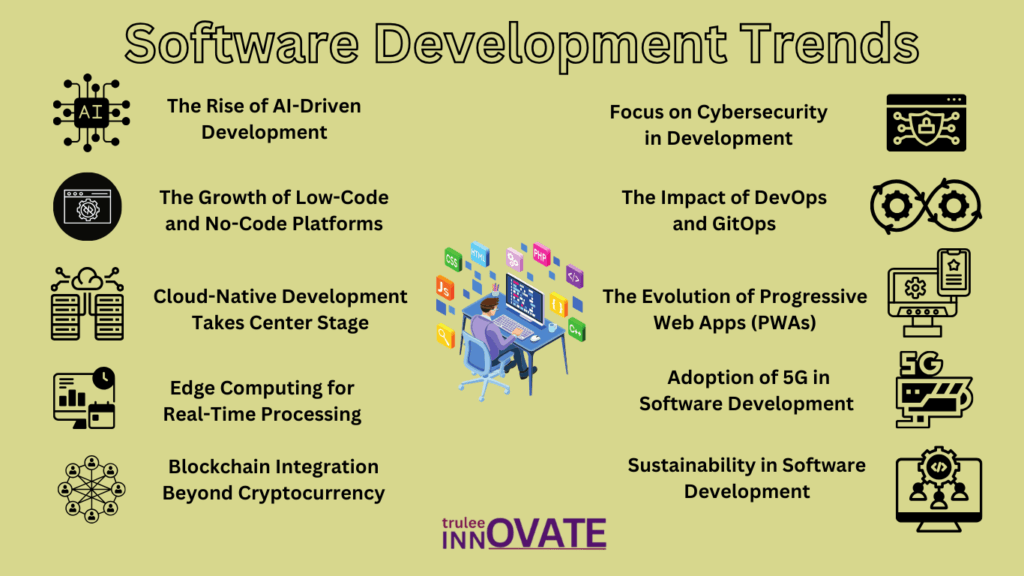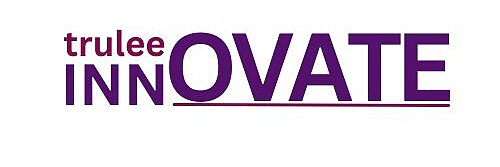Introduction: Why Staying Updated with Software Development Trends Matter
The world of software development is evolving at an unprecedented pace. Businesses that wish to remain competitive must adapt to the latest trends in software development shaping the industry. From artificial intelligence (AI) to sustainable coding practices, understanding these new trends in software development is essential for creating efficient and future-proof solutions.
This blog explores the software development trends in 2025, equipping businesses and developers with insights they need to stay ahead.
Trend 1: The Rise of AI-Driven Development
Artificial Intelligence (AI) is transforming the way software is created, implemented, and managed. AI-driven development involves leveraging AI tools and frameworks to optimize various stages of the software development lifecycle.
Role of Artificial Intelligence in Coding and Testing
AI-powered tools like GitHub Copilot and DeepCode assist developers by suggesting lines of code, automating repetitive tasks, and even identifying potential bugs. These tools significantly reduce development time and improve code quality.
Tools Empowering AI Development
- TensorFlow and PyTorch: Widely used for building AI-driven applications.
- TabNine: An AI-powered code completion tool.
- AI-assisted testing tools like Testim automate testing, ensuring faster and more reliable QA.
Artificial Intelligence (AI) is transforming the way software is created, implemented, and managed. AI-driven development involves leveraging AI tools and frameworks to optimize various stages of the software development lifecycle.
Trend 2: The Growth of Low-Code and No-Code Platforms
The demand for rapid application development has propelled the popularity of low-code and no-code platforms. These platforms enable non-technical users to create applications without deep coding knowledge.
Benefits of Low-Code/No-Code for Businesses
- Faster Development Cycles: We can now finish projects in weeks instead of months as they used to.
- Cost Efficiency: Reduces the need for extensive developer teams.
- Accessibility: Empowers employees across departments to build solutions.
Examples of Popular Platforms
- Microsoft Power Apps: Simplifies enterprise-grade app creation.
- OutSystems: A robust low-code platform for developing and deploying applications.
- Bubble: Popular among startups for creating MVPs quickly.
Trend 3: Cloud-Native Development Takes Center Stage
The shift to cloud-native development continues to dominate, offering businesses unmatched scalability, resilience, and flexibility.
Embracing Serverless Architecture
Serverless computing eliminates the need for managing infrastructure, allowing developers to focus solely on writing code. Services like AWS Lambda and Google Cloud Functions have become integral to modern applications.
Multi-Cloud Strategies and Their Importance
Businesses increasingly adopt multi-cloud strategies to avoid vendor lock-in and ensure greater redundancy. Tools like Kubernetes and Terraform facilitate seamless multi-cloud deployments.
Trend 4: Edge Computing for Real-Time Processing
As the demand for real-time data processing grows, edge computing has emerged as a critical trend. It processes data closer to its source, reducing latency and bandwidth usage.
Why Edge Computing is Vital for IoT and AI
Edge computing enables Internet of Things (IoT) devices to perform faster and more efficient computations. This is particularly useful for applications like autonomous vehicles and smart cities.
Use Cases Across Industries
- Healthcare: Real-time patient monitoring systems.
- Retail: Smart shelves and inventory management.
- Manufacturing: Predictive maintenance in factories.
Trend 5: Blockchain Integration Beyond Cryptocurrency
Blockchain technology is no longer limited to cryptocurrency. In 2025, its applications extend to cybersecurity, supply chain management, and beyond.
Blockchain in Cybersecurity and Supply Chain
- Cybersecurity: Ensures secure data sharing and prevents unauthorized access.
- Supply Chain: Offers transparency and traceability, reducing fraud.
Smart Contracts Revolutionizing Transactions
Smart contracts automate and enforce agreements without the need for intermediaries, making processes faster and more reliable.
Trend 6: Focus on Cybersecurity in Development
With the increasing number of cyber threats, integrating cybersecurity into the development process is no longer optional.
Shift-Left Security Practic
The phrase “shifting left” describes the practice of introducing security features early in the software development process.This proactive approach minimizes vulnerabilities and reduces costs.
Tools for Ensuring Secure Software Development
- Snyk: Helps developers find and fix vulnerabilities in open-source libraries.
- Checkmarx: Offers static application security testing (SAST).
- OWASP ZAP: An open-source tool for identifying security risks
Trend 7: The Impact of DevOps and GitOps
DevOps has long been a critical methodology for software development, and GitOps is its latest evolution, emphasizing automation and version control.
Streamlining Development with Automation
DevOps and GitOps automate repetitive tasks, such as deployments and monitoring, leading to faster release cycles.
Continuous Integration and Delivery
Continuous integration and delivery (CI/CD) pipelines ensure that code changes are automatically tested and deployed, enhancing reliability and speed.
Trend 8: The Evolution of Progressive Web Apps (PWAs)
Progressive Web Apps (PWAs) blur the line between web and mobile applications, offering users an app-like experience without requiring downloads.
Benefits of PWAs for Businesses
- Improved User Experience: Faster load times and offline functionality.
- Cost Savings: Eliminates the need for separate native apps.
Key Examples of Successful PWAs
- Twitter Lite: Reduces data usage while delivering an engaging experience.
- Starbucks PWA: Offers offline ordering functionality.
Trend 9: Adoption of 5G in Software Development
The rollout of 5G networks is revolutionizing software development trends in 2025, particularly for mobile and IoT applications.
Enhancing Mobile Application Performance
5G enables faster data transfer speeds, improving the responsiveness of mobile applications and enhancing user experiences.
Opportunities for Real-Time Applications
- Augmented Reality (AR) and Virtual Reality (VR): Immersive experiences with minimal latency.
- Smart Cities: Seamless integration of connected devices.
The rollout of 5G networks is revolutionizing software development trends, particularly for mobile and IoT applications.
Trend 10: Sustainability in Software Development
As the focus on environmental impact grows, sustainability in software development has become a significant trend.
Green Coding Practices
- Writing energy-efficient code.
- Optimizing resource usage in applications.
Energy-Efficient Development Tools
- ECO Assistant: Helps measure and reduce energy consumption during development.
- AWS Carbon Footprint Tool: Tracks and minimizes cloud usage impact.

How Businesses Can Leverage These Trends in 2025
To stay competitive, businesses must:
- Invest in training developers on the latest tools and methodologies.
- Partner with innovative tech providers.
- Regularly evaluate and adopt emerging technologies.
By focusing on new trends in software development like AI, cloud-native tools, and sustainability, businesses ensure they stay agile in a changing environment.
Challenges in Keeping Up with Software Development Trends
- High Costs: Adopting new technologies can be expensive.
- Skill Gaps: Finding talent skilled in emerging technologies is challenging.
- Rapid Changes: Trends evolve quickly, making it hard to keep up.
Conclusion: Shaping the Future with Emerging Software Development Trends
The software development trends in 2025 highlight the importance of agility, innovation, and sustainability. From AI-driven tools to green coding practices, embracing these trends in software development will pave the way for long-term success. Staying informed and proactive is the key to leveraging these advancements and driving growth.
FAQs
1. What are the major software development trends in 2025?
Some of the biggest software development trends in 2025 include AI-driven development, low-code/no-code platforms, edge computing, blockchain integration, and sustainable coding practices.
2. Why is it important to follow new trends in software development?
Following new trends in software development ensures businesses remain competitive, reduce costs, and deliver innovative solutions to meet market demands.
3. How do trends in software development impact businesses?
Emerging trends in software development improve efficiency, strengthen cybersecurity, and enable faster product delivery, helping businesses scale effectively.
4. Which tools support the latest software development trends?
Popular tools include TensorFlow, Kubernetes, AWS Lambda, and Snyk—all supporting different aspects of modern development practices.
5. What challenges do businesses face in keeping up with software development trends?
High costs, skill shortages, and the rapid pace of change are the biggest hurdles. However, proactive learning and adopting scalable solutions can bridge the gap.


